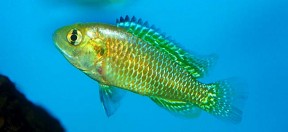Pseudocrenilabrus multicolor
Dwarf Egyptian Mouth-brooder
Classification
Cichlidae
Distribution
Egypt, Rwanda, Uganda, Sudan, Tanzania and Kenya.
Habitat
It is found in streams, ponds and lake tributaries. The water is usually slow-moving or completely still, and the fish are commonly found around the stems of aquatic plants or under cover of floating vegetation.
Maximum Standard Length
3.2″ (8cm).
Aquarium SizeTop ↑
24″ x 15″ x 12″ (60cm x 37.5cm x 30cm) – 71 litres is suitable for a pair. A larger tank is needed for a harem.
Maintenance
The tank should contain plenty of hiding places. Clay pot caves, roots and pieces of driftwood can all be used. Plants are not essential but the fish will appreciate the additional cover. A sand or fine gravel substrate is best as the male will dig when spawning.
Water Conditions
Temperature: 68-79°F (20-26°C)
pH: 6.5-7.2
Hardness: 5-15°H
Diet
Will accept most foods. A good quality cichlid pellet can be fed as staple, but ensure the diet is varied with regular feedings of live and frozen foods.
Behaviour and CompatibilityTop ↑
Can be aggressive towards other species inhabiting the lower reaches of the aquarium. If you wish to keep it with other dwarf cichlids, catfish, loaches etc. you will need a large tank. In smaller aquaria good tankmates include African tetras and small surface dwelling species such as hatchetfish. Male fish are very aggressive towards one another and only one should be kept in a harem situation with several females.
Sexual Dimorphism
Males tend to be a little larger than females and are more colourful, especially when breeding.
Reproduction
Quite easy. Maternal mouth-brooder. The breeding aquarium should be set up as suggested above. The fish will breed over a fairly wide range of water parameters. Aim for a pH of around 7.0 and a temperature of 75°F and you should be fine. Try and purchase a single male fish and 3-4 females. If this is not possible get a group of 6-8 young fish and allow things to develop naturally. If the fish are conditioned on a high quality diet of frozen and live foods they should come into breeding condition quite quickly.
When in condition the male will excavate a shallow pit in the substrate. From here he will display to females, attempting to entice them to spawn with him. The male can be quite forceful in his seduction attempts and this is why it is preferable to spawn this species in a harem situation as the male’s attention is divided.
When a female is willing she will follow the male to his pit, where spawning occurs. The act itself is preceded by a display of circling by both fish. The male will nuzzle the vent of the female, and it may be this that triggers her to release the eggs. As the eggs are laid the female immediately picks them up with her mouth and then mouths the vent of the male, who releases some milt directly into the mouth of the female. Sometimes fertilisation occurs before the female picks up the eggs as the fish circle quite quickly. The male has an orange spot on his anal fin and it has been hypothesised that this may act as a kind of ‘dummy egg‘ to attract the female to his vent. However if the fish are watched closely it appears this may not be the case, as the vent of the male is not actually very close to the ‘egg spot‘, and the female tends to mouth the vent itself. This sequence is repeated until the female is holding 5-100 eggs in her buccal cavity.
The female will hold the brood for around 10 days, at which point the free swimming fry are released. They can be fed brine shrimp nauplii, microworm and powdered dried foods from this point.
NotesTop ↑
This species was one of the first cichlid species to be spawned in captivity and has been in the hobby for over a century. It is less popular than it once was but remains a good choice for the beginner as it is tolerant of a wide range of water conditions and is easily bred.
There currently exist 2 subspecies, Pseudocrenilabrus multicolor multicolor and P. m. victoriae. These are quite distinct in terms of colouration and patterning and exist as separate populations in nature. Both subspecies are available in the hobby, though P. m. victoriae is less common. They should not be kept together in aquaria in order to prevent hybridisation.



